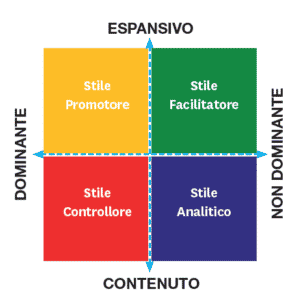
How to Manage Stress
14 March 2017
FACS: an atlas for exploring emotions through the face
14 April 2017THE RELATIONSHIP IN COLORS – The Persuasive Communicator™
THE THEORIES, MODELS AND STUDIES on communication are so numerous that it is very difficult, if not entirely futile, to attempt a synthesis.
There is one aspect, however, on which most of the different approaches seem to converge: everything we know about communication processes teaches us that the exchange of content, the possibility of understanding each other and having effective communication, depends very much on the level of harmony that can be established between the communicators.
Each of us, however, is different, we carry different motivations and representations of the world, and if we want to be in tune with our interlocutors, we cannot relate to everyone in the same way.
But how is it possible to recognise these differences? How do we make sense of the kaleidoscope of colours that make up our different personalities?
As explorers moving through an unknown world, we need a map. Constructing maps, models capable of reducing the enormous complexity of human nature, and thus giving us a ‘compass’ capable of pointing us in the right direction, is a game with which the pioneers of psychology have grappled from the very beginning: Freud, Jung and Reich for example, to name a few of the most important. From these studies descend some of the tools in use today.
Persuasive Communicator by Personal Global is a model that stems from a matrix that identifies four different behavioural orientations: Expansive; Content; Dominant; Non-dominant.
Four different communication styles emerge from the intersection of these four characteristics:
– Promoter style: characteristic of people who are flexible, energetic, creative, stimulated by situations of visibility and personal recognition;
– Facilitator style: represented by sensitive and collaborative people, who like to build relationships based on trust and acceptance of others;
– Analytical style: within which we find reflective people, measured in their relational manifestations, who attach great importance to the objective dimension and consistency;
– Controller Style: characterised by determined, pragmatic, results-oriented people who are motivated by the achievement of goals and personal fulfilment.
Personal training based on this tool facilitates the development of an appropriate level of awareness.
Once this model has been assimilated, it is quite easy to identify, in a relatively short time, the main characteristics of our interlocutors.
Obviously, the awareness process would be incomplete, and completely ineffective, if we did not also turn the same level of observation towards ourselves.
While it is true that we can learn to recognise the prevailing communication style of our interlocutors, we cannot ask them to adapt to our characteristics; the responsibility for initiating the process that helps to develop greater attunement is, at least in the first instance, our own.
Communication is a relationship process.
Awareness of the importance and value of the relationship is a prerequisite for an effective approach to communication.
But what goes on in the relationship is little known; at school no one taught us the ‘grammar of the relationship’, but once this awareness has been achieved, it is crucial to understand the importance of taking responsibility for change: an attitude geared towards evolving the communication system in which we are involved, with the aim of achieving greater harmony and quality in the communicative exchange.
Persuasive Communicator by Personal Global is a tool that helps us develop awareness and a sense of responsibility for the communication process.
Abandoning the static or merely informative vision, this model makes us realise the importance of relationship management and the strategic value of understanding the other’s needs for a dynamic and effective approach to communication.



